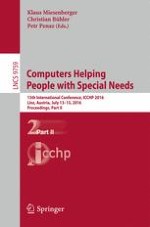2016 | OriginalPaper | Chapter
User Requirements Regarding Information Included in Audio-Tactile Maps for Individuals with Blindness
Authors : Konstantinos Papadopoulos, Konstantinos Charitakis, Lefkothea Kartasidou, Georgios Kouroupetroglou, Suad Sakalli Gumus, Efstratios Stylianidis, Rainer Stiefelhagen, Karin Müller, Engin Yilmaz, Gerhard Jaworek, Christos Polimeras, Utku Sayin, Nikolaos Oikonomidis, Nikolaos Lithoxopoulos
Published in: Computers Helping People with Special Needs
Publisher: Springer International Publishing
Activate our intelligent search to find suitable subject content or patents.
Select sections of text to find matching patents with Artificial Intelligence. powered by
Select sections of text to find additional relevant content using AI-assisted search. powered by
